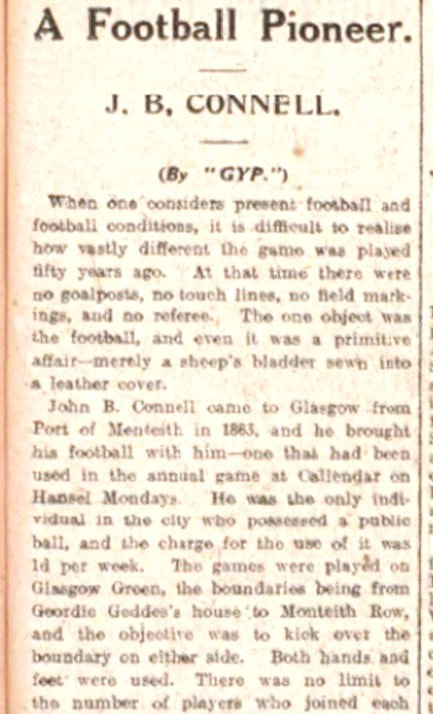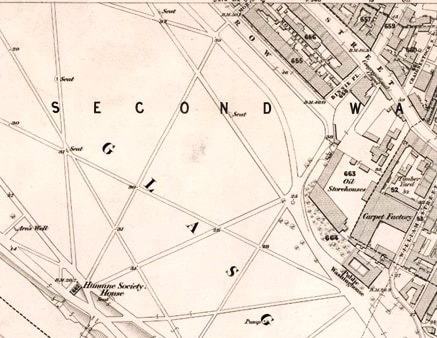The answers lie in the hidden history of football in Glasgow before Queen's Park came on the scene, with a man called John B Connell claiming to have brought the first football to the city several years earlier.
The traditional version of events was written by Richard Robinson in the Queen's Park jubilee history, where he asserted that there was no serious football in the city before the club was founded on 9 July 1867: 'Football was played in a more or less happy-go-lucky fashion in the Queen's Park and Glasgow Green. Play with the round ball was then comparatively new, and had not yet been systematised in Scotland.'
Robinson described how Queen's Park was founded after a few young men from the north of Scotland were engaged in athletic pursuits near to a group of YMCA members who were playing football. Sometimes the game spilled over into the athletics area, so the northerners challenged the YMCA boys. They enjoyed football enough to start playing regularly 'to amuse themselves, among themselves, in their own way,' and then decided to form a proper club. The rest is history as Queen's Park blazed a trail for association football in Scotland.
However, it is clear that football was already a popular recreation in Glasgow long before 1867, although frustratingly for historians there are only tantalising glimpses of football in the press and written records.
For example, in the summer of 1862 the Glasgow Abstainers' Union took over Gilmorehill Recreation Grounds to promote outdoor activities, and top of their list was football. Although it was initially described as 'the ancient and praiseworthy pastime of football', the activity was soon disparaged by an English observer in a letter to the Glasgow Morning Journal: 'Football as we play it in England, with two sides, and a goal to be kept by one of them, is a noble game. Here there was no game. By the English eye a mob of people kicking a ball about quite aimlessly and at random could only be regarded as a pitiful congregation of blockheads working off their superfluous physical energies in a particularly insane and stupid manner.' (7 May 1862)
This drew an angry riposte from 'A Scotchman' who wrote: 'Failing to discover the drunkenness over which he would have gloated with delight, he gives vent to his bile in a scurrilous attack on the play at foot-ball, which was not managed, he says in the English style. It may be right, perhaps, to let this conceited Englishman know that the game of football is as well understood in all parts of Scotland as England.' (9 May 1862)
It appears the Abstainers' Union were scared off by the bad publicity and they abruptly ended the short-lived experiment with the stark announcement: 'Foot-Balling has been discontinued in consequence of interfering with the comfort of visitors'. The game was simply too popular.
Although the city's first rugby clubs were founded at West of Scotland (1865) and Glasgow Academicals (1866), there are precious few mentions of football in the press until Queen's Park advertised the start of their first summer season in March 1868, shortly followed by their annual meeting on 4 April.
That summer they decided to broaden their horizons beyond their own membership and, according to Robinson: 'It was found that there were in existence other clubs in exactly the same position as the Queen's Park, on the lookout for opponents.'
Two challenges were received: one from Ayr FC, the other from the Thistle FC, whose headquarters were on Glasgow Green. A trip to Ayr was deemed impractical on financial grounds, so the game with Thistle was arranged and a letter from Robert Gardner, accepting the challenge, is in the Scottish Football Museum. It was addressed to Andrew Holmes, secretary of the Thistle Football Club, which indicates a properly organised club.
A few days later, the teams met at the Queen's Park Recreation Ground, with Queen's Park winning by two goals to nil. Association football had arrived in Glasgow.
What of their opponents? To establish the story of the Thistle Football Club one has to depend on later reminiscences, some of which contradict what Robinson wrote in the Queen's Park history.
I was first alerted to an anecdote published in a 1934 book, The Mighty Kick. The authors wrote that 'John Connal [sic] brought the first football to Glasgow in 1862, having been brought up on the traditions of Hansel Monday in Callander, and helped to found the Thistle Football Club at Glasgow Green. Callander boys came to Glasgow and played football at Monteith Row, Glasgow Green, where the People's Palace now stands, paying a penny a week to take part. They wore the colours of Drummond Castle, which was owned by Baron Willoughby d'Eresby. This included tartan caps.'
I found more of Connell's story in a couple of newspaper articles which described how he made the transition from the rural football of Perthshire to the organised game in Glasgow.
'He was the only individual in the city who possessed a public ball, and the charge for the use of it was a penny a week. The games were played on Glasgow Green, the boundaries being from Geordie Geddes's house [ie the Glasgow Humane Society] to Monteith Row, and the objective was to kick over the boundary on either side. Both hands and feet were used. There was no limit to the number of players who joined each side, once the penny was paid. These games ultimately culminated in the formation of the Thistle, in which Connell took a prominent part, though prior to that there was the Drummond Club, composed of Callander men.'
'The challenge limited the teams to eleven a side, and each club had to furnish a football, the visitors using theirs in the first half and the home team theirs in the second half. There was no referee, no goal nets, not even touch lines, merely an umpire for each side. The game was the chasing of a football, the fastest runners and the hardest kickers being the champions. Combination was unheard of, but dribbling was a fine art and everything was subordinated to footwork, fast running and vigorous shoulder charging.
'Each club had its own rules, the matches being played under the ruling of the home club. Against Drummond, the Queen's stipulated no tripping, in which the Perthshire players specialised. Their football was a hybrid type between present day Association and Rugby with tripping thrown in.'
This gives rise to some confusion, as Queen's Park played Thistle in 1868 (20-a-side) and Drummond in 1870 (18-a-side), so recollections of the two matches appear to have been muddled.
His full name was John Burns Connell and he was born in Doune in 1846, then brought up on a farm near Port of Menteith, a few miles south of Callander. He clearly took part in the annual football match there and after coming to Glasgow to work in the early 1860s he continued to enjoy the game and appears to have been the captain of both the Thistle and the Drummond teams.
Later he played for Callander (a Glasgow club) in the first ever Scottish Cup tournament in 1873, after the club subscribed £1 for the purchase of the trophy. He then joined Eastern, a club which produced many prominent players, notably the Scotland internationalists Peter Andrews, JJ Lang, Alex Kennedy and WS Somers. Ultimately Eastern became one of the forerunners of Clyde FC.
He remained in Glasgow for the rest of his life and worked for over 50 years as a draper and warehouseman with J&W Campbell. He died in Scotstoun in 1930, aged 84, and although he and his wife Louisa had two children, there are not thought to be any living descendants.
There are no known photos of Connell, which is unfortunate as he is a key figure in the early development of football. Similarly, there is no documentary evidence of the Thistle or Drummond clubs.
As research into the story of early Scottish football continues, I hope that, in time, the contributions of John B Connell and his fellow players from Callander will become better known and appreciated.
**Update - following the digitisation of the Daily Record by the British Newspaper Archive, a lengthy article by Connell has come to light. Published three years after his death, it is a detailed and fascinating account of the pre-history of football in Glasgow.







 RSS Feed
RSS Feed